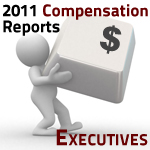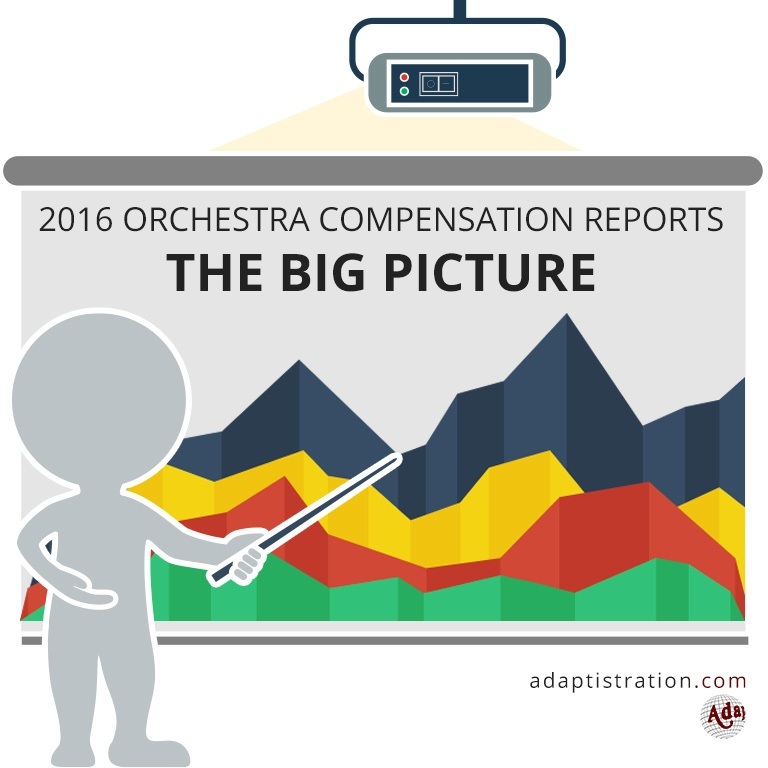Although the 2008/09 season was the first to endure the economic downturn, the average orchestra executive didn’t experience an adverse impact on their compensation. In fact, the average compensation level increased 5.43 percent…
WHAT’S NEW FOR THE 2011 REPORTS
 Thanks to the use of dynamic sorting tables, the 2001 Orchestra Compensation Reports can combine and display all of the data from both ICSOM and ROPA executives in a single chart. This means you can interact with the data and arrange it in a variety of ways; high/low compensation figures, total expenditure, conference or group, alphabetic by name, etc.
Thanks to the use of dynamic sorting tables, the 2001 Orchestra Compensation Reports can combine and display all of the data from both ICSOM and ROPA executives in a single chart. This means you can interact with the data and arrange it in a variety of ways; high/low compensation figures, total expenditure, conference or group, alphabetic by name, etc.
WHERE THE DATA COMES FROM
In order to provide information that is as accurate as possible, data from the 2008/09 season is gathered from the following sources:
- Executive compensation figures were obtained from their respective orchestra’s IRS Form 990 for the 2008/09 concert season.
- Total Expenditures were also obtained from each respective orchestra’s IRS Form 990 for the2008/09 concert season.
- Base Musician compensation figures were obtained from records collected by the American Federation of Musicians (AFM) and International Guild of Symphony, Opera, and Ballet Musicians (IGSOBM, Seattle) for the 2008/09 concert season.
Adaptistration makes no claim to the accuracy of information from documents compiled or reported by external sources. If you have reason to believe any of the information is inaccurate or has changed since reported in any of the above sources and you can provide documentation to such effect, please feel free to submit a notice.
Show the Content
NOTICE
GuideStar has been informed by the IRS of processing errors on IRS Forms 990 filed electronically between January 1, 2009, and December 3, 2010, for form year 2008. These processing errors resulted in inaccurate data appearing on the scanned images of the affected returns that are posted on GuideStar and do not reflect the information filed with the IRS.
These errors include:
- Part III, line 1, organization’s mission description—may not reflect what was originally submitted by the nonprofit organization.
- Part VIII, line 8a, gross income for special events—values may have been transposed.
- Part IX, line 7c, other salaries and wages, management and general expenses—may show a blank where a value was originally reported.
- Schedule D, Part V, line 3a(ii), endowment funds and possession by related organizations— checkbox values may have been transposed.
GuideStar is working with the IRS to obtain a corrected copy of its form year 2008 Form 990. GuideStar will replace this Form 990 if, and when, the accurate return is made available from the IRS. For more information, please visit http://www2.guidestar.org/rxg/help/form-year-2008-returns.aspx
WHAT THE NUMBERS DON’T SHOW
It is important to remember that the numbers shown do not always convey a complete compensation picture. For example, an orchestra executive may have had a large increase in salary due to a contractually mandatory severance or deferred compensation package. Additionally, if any executive was not employed for a full season, the documents used to gather this data do not indicate how much of the season the individual received a salary. As such, the cumulative compensation may artificially inflate annual earnings. Conversely, reported figures may not reflect bonuses or other incentive payments and may therefore under report what executives actually earn; as a result, the cumulative compensation for executive directors may or may not be more than what is listed.
ICSOM Base Musician Figures
The “Base Musician” compensation figures do not include any additional payments including, but not limited to, outreach services and minimum overscale and/or seniority payments. Finally, these figures do not include any of the opera, ballet, or festival orchestras which are members of ICSOM or IGSOBM.
ROPA Base Musician Figures
As for Regional Orchestra Player Association (ROPA) musicians, unlike the vast majority of their peers in ICSOM ensembles who all earn no less than the musician base salary, all ROPA ensembles use a tiered system of salary and/or per service payments. For example, although an ensemble with a multi-tier system like this may list a base musician salary of $30,000 more than 60 percent of the musicians earn less than that base salary figure. Those players are paid via sliding per service tier system and may earn as little as a few thousand dollars per season.
In the strictly per service ensembles, the figures listed in the Base Musician compensation column are actually the average annual income earned by section string players (or section wind players if no information for the string players was available). This figure is reported by the AFM because it best represents annual earnings for the musicians who perform the greatest number of services in any per service orchestra; string musicians. However, those compensation figures are not always guaranteed. Additionally, the Base Musician figures do not include any additional payments offered by some organizations such as voluntary outreach services, and minimum overscale payments. Finally, opera or ballet organizations are not included in these reports, only symphonic and chamber orchestra ensembles.
QUICK FACTS
From the 2007/08 to the 2008/09 season…
- the average ICSOM executive compensation increased 2.20 percent.
- the average ICSOM base musician compensation increased 3.36 percent.
- the average ROPA executive compensation increased 8.64percent.
- the average ROPA base musician compensation increased 1.04 percent.
TOP 10 EARNERS
- Los Angeles Philharmonic: $1,393,112
- New York Philharmonic: $1,017,074
- Boston Symphony: $606,725
- Cincinnati Symphony: $562,829
- Atlanta Symphony: $553,794
- Chicago Symphony: $513,659
- San Francisco Symphony: $480,989
- Cleveland Orchestra: $472,220
- Philadelphia Orchestra: $447,953
- St. Paul Chamber Orchestra: $444,854
- Pacific Symphony: $266,788
- Toledo Symphony: $256,345
- Omaha Symphony: $219,517
- Grand Rapids Symphony: $154,434
- Rhode Island Philharmonic: $145,071
- Santa Rosa Symphony: $141,537
- Austin Symphony: $137,534
- Richmond Symphony: $125,746
- Memphis Symphony: $122,885
- Spokane Symphony: $122,883




Drew,
I wish you would include the Opera Organizations either as part of each ROPA and ICSOM list or as a separate grouping of organizations.
We share the same wish but in the same way that the website reviews have a cut off point, so do the compensation reports. It all comes down to a matter of time. Since this is all a labor of love and reader supported, there are only so many hours I can set aside to compile and track the data. I’ve always said that I would be open to having the reports sponsored in order to provide a greater sampling as well as provide all of the historical data currently available via paid subscription at Adaptistration Premium. So if there’s anyone out there interested in sponsoring the reports, feel free to get in touch.